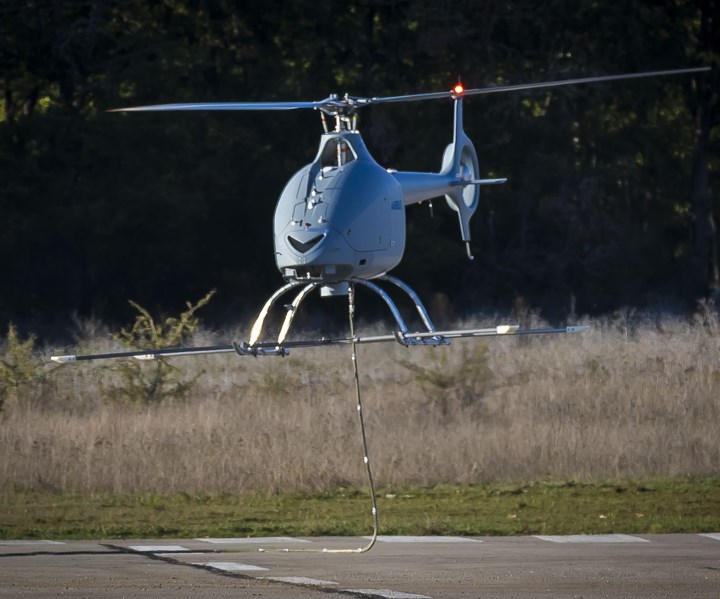Airbus naval unmanned aerial vehicle prototype performs first flight
The next step for the VSR700 unmanned aerial system prototype is free flight testing, moving toward performance trials with the French Navy in 2021.

Source | Airbus Helicopters
On Nov. 8, a prototype of Airbus Helicopters’ (Marignane, France) VSR700 unmanned aerial system performed its first flight at a drone test center near Aix-en-Provence, France. According to Airbus, the VSR700 performed several take-offs and landings, with the longest flight lasting around 10 minutes.
In accordance with the airworthiness authority that provided the flight clearance, the VSR700 was tethered with 30-meter cables to fully secure the flight test zone. The subsequent phases of the flight test program will now evolve towards free flight, and then progressively open the flight envelope.
The VSR700 is derived from Hélicoptères Guimbal’s (Aix-en-Provence, France) Cabri G2 helicopter, and is intended for use by the French Navy. It is an unmanned aerial system in the 500-1000-kilogram maximum take-off weight range, and according to Airbus, it offers an optimal balance of payload capability, endurance and operational cost. It is reportedly capable of carrying multiple full-size naval sensors for extended periods and can operate in existing ships, alongside a helicopter, with a low logistical footprint.
“The VSR700 is a fully-fledged unmanned aerial system, capitalizing on Airbus Helicopters’ extensive experience of advanced autopilot systems and engineering expertise to provide modern militaries with new capabilities,” says Bruno Even, Airbus Helicopters CEO. “This first flight of the VSR700 prototype is a major milestone for the program as we make progress on the operational demonstrator for the French Navy that will perform trials in 2021 in partnership with Naval Group.”
Airbus also reports that the current VSR700 prototype is a step change from the optionally piloted demonstrator that first flew in 2017, and which was based on a modified Cabri G2 equipped for autonomous flight. Compared to the demonstrator, the VSR700 prototype has a specialized set of avionics and an advanced flight control system, a payload bay in place of the pilot station designed to manage mission equipment, as well as a sleeker, more aerodynamic shape to improve flight performance.
Related Content
-
Industrializing additive manufacturing in the defense/aerospace sector
GA-ASI demonstrates a path forward for the use of additive technologies for composite tooling, flight-qualified parts.
-
Converting carbon fiber for UHTCMC to 3500°C
Advanced Ceramic Fibers LLC demonstrates ultra-high temperature ceramic matrix composites using SiC and other metallic carbides for applications in aerospace, defense, energy and more.
-
From the CW Archives: Airbus A400M cargo door
The inaugural CW From the Archives revisits Sara Black’s 2007 story on out-of-autoclave infusion used to fabricate the massive composite upper cargo door for the Airbus A400M military airlifter.
.jpg;width=70;height=70;mode=crop)





